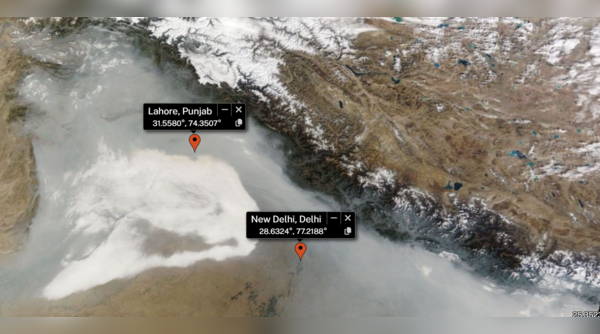- News
- India News
- In pictures: Nasa satellite captures toxic smog blanket over Lahore and New Delhi
In pictures: Nasa satellite captures toxic smog blanket over Lahore and New Delhi

Nasa shares satellite images of thick smog blanketing Lahore to Delhi
Nasa’s satellite imagery has captured a dense layer of smog engulfing eastern Pakistan and northern India, covering major cities like Lahore and New Delhi. This toxic blanket of grey haze is visible from space and has prompted immediate health concerns, affecting millions of people. In Lahore, with over 14 million residents, the pollution crisis has reached unprecedented levels, highlighting the severe impact of industrial emissions, vehicle exhaust, and crop burning. (Image by Nasa world view)

Air pollution reaches record levels in Lahore and New Delhi
The air quality in Lahore and New Delhi has deteriorated to hazardous levels. In Lahore, the Air Quality Index (AQI) skyrocketed to 1165, while Delhi and its surrounding areas hovered around 350. The safe AQI threshold is below 50, far from the current alarming figures. This thick smog has led to an emergency response in Pakistan, as authorities race to address the immediate health risks posed to residents, particularly the vulnerable. (Image by Nasa world view)

Health emergencies prompt school closures in Pakistan
With Lahore's air quality in the hazardous range, Pakistani authorities have closed schools and restricted outdoor activities to protect children and residents from the severe pollution. Until November 17, children are staying indoors as schools remain shut to prevent exposure to toxic air. Alongside school closures, warnings have been issued for elderly residents and those with respiratory conditions who face heightened health risks due to the pollution crisis. (Image by Nasa world view)

Multan records an unprecedented AQI of 2,135 amid smog crisis
In Multan, approximately 350 kilometres from Lahore, the AQI spiked to a staggering 2,135, with PM2.5 levels at 947 micrograms per cubic metre—189 times above WHO’s safe limits. The AQI in Multan remained three times above the hazardous threshold of 300, with residents facing severe respiratory risks. In response, the government has banned access to parks and zoos, and limited pollution from sources like tuk-tuks and unfiltered barbecue restaurants. (Image by Nasa world view)

WHO warns of severe health risks from toxic air pollution
According to the World Health Organization, prolonged exposure to high pollution levels can lead to severe health issues, including strokes, heart disease, lung cancer, and respiratory conditions. Particularly at risk are children, the elderly, and those with pre-existing health problems. In Lahore, PM2.5 particles from fossil fuel combustion, dust storms, and wildfires pose the greatest danger, linked to asthma, heart and lung disease, and cognitive impairment in children.

Punjab's ‘smog war room’ targets pollution sources
In an attempt to combat the pollution crisis, a “smog war room” has been established in Pakistan’s Punjab province. Staffed by officials from eight departments, the war room is tasked with addressing causes of pollution, such as crop stubble burning and traffic congestion. Efforts are being made to reduce emissions and improve air quality, though the scale of pollution means immediate improvements are unlikely, leaving millions to face serious health threats.

Factory emissions, vehicle exhaust, and stubble burning causes smog crisis
A combination of industrial pollution, traffic emissions, and crop stubble burning is driving the smog crisis in Lahore and Delhi. Cooler winter temperatures and slower winds trap the pollutants, allowing the toxic haze to linger over cities. During this season, agricultural burning in rural areas adds to urban emissions, creating a toxic mix that suffocates millions of residents and escalates air quality levels to hazardous figures.









